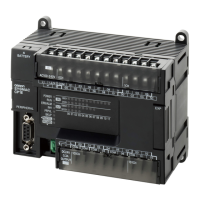9-41
9 Using Expansion Units and Expansion I/O Units
CP1E CPU Unit Hardware User’s Manual(W479)
9-4 Temperature Sensor Units
9
9-4-4 Flow of Processing
(3) Startup Operation
After power is turned ON, approximately 1 s is required for the first conversion data to be
stored in the input word. During that period, the data will be 7FFE. Therefore, create a pro-
gram as shown below, so that when operation begins simultaneously with startup it will wait
for valid conversion data.
(4) Handling Unit Errors
• Expansion Unit and Expansion I/O Unit errors are output to bits 0 to 5 of word A436. The
bits are allocated from A436.00 in order starting from the Unit nearest the CPU Unit.
CP1W-TS002 and CP1W-TS102 Temperature Sensor Units are allocated two bits each.
Use these flags in the program when it is necessary to detect Expansion Unit/Expansion
I/O Unit errors.
• When an error occurs, the Temperature Sensor Unit data becomes 7FFF hex (the same
as for an open-circuit detection). With an open-circuit detection, it is not reflected in word
A436.
(5) Programming Example (CPU Unit with 30 or 40 I/O Points)
(a) The following programming example shows how to convert the input data from 2
temperature sensor inputs to BCD and store the result in D0 and D1.
Temperature unit 0 (°C)
Number of decimal places 0 (normal)
Input range setting 1 (K: 0.0 to 500.0°C)
Input 0 CIO 2
Input 1 CIO 3
(P_EQ)
W0.00
2
#7FFE
P_On
CMP
Always ON
Temperature input data
output word
Initialization
Completed Flag
CPU Unit
CP1W-TS001/101
Temperature Sensor Unit
Inputs
Outputs
CIO 0
CIO 1
CIO 100
CIO 101
CIO 2
CIO 3
None

